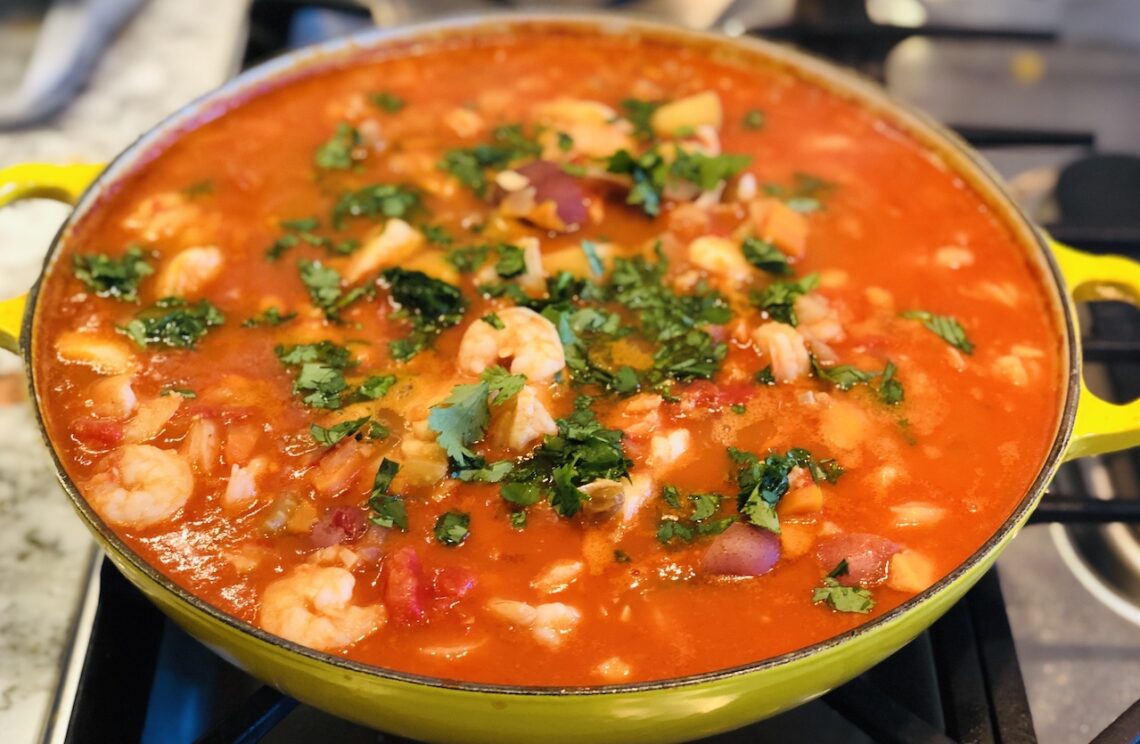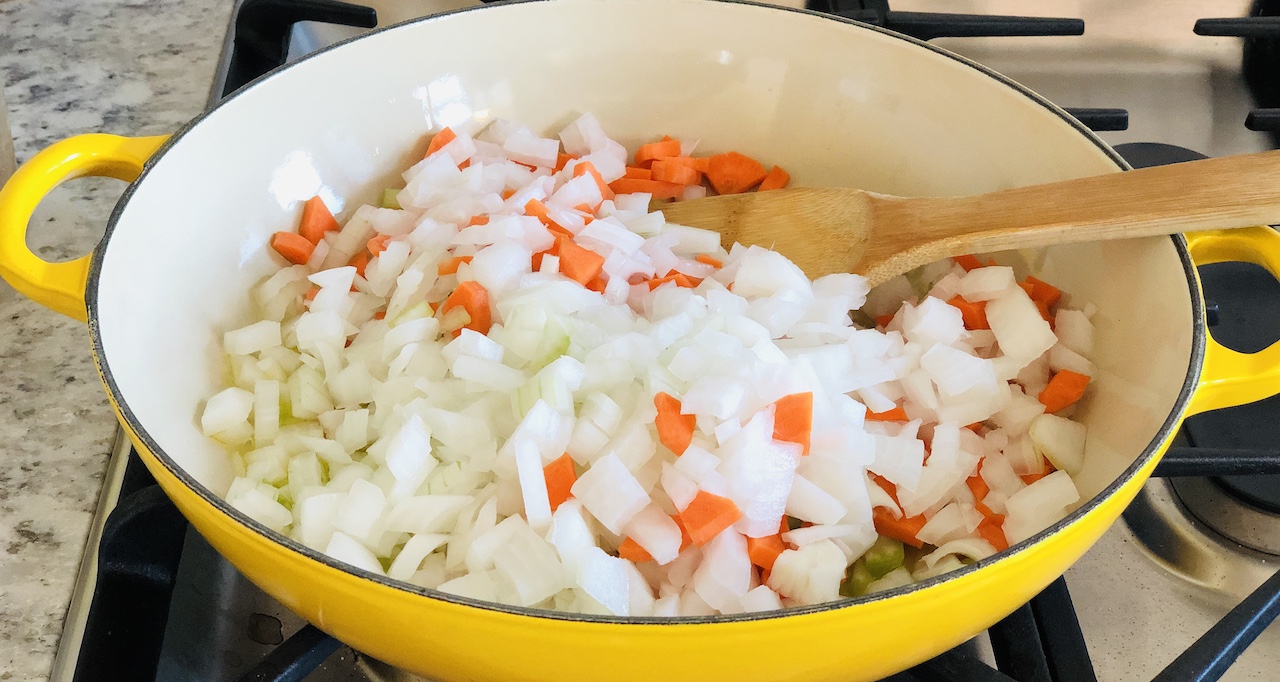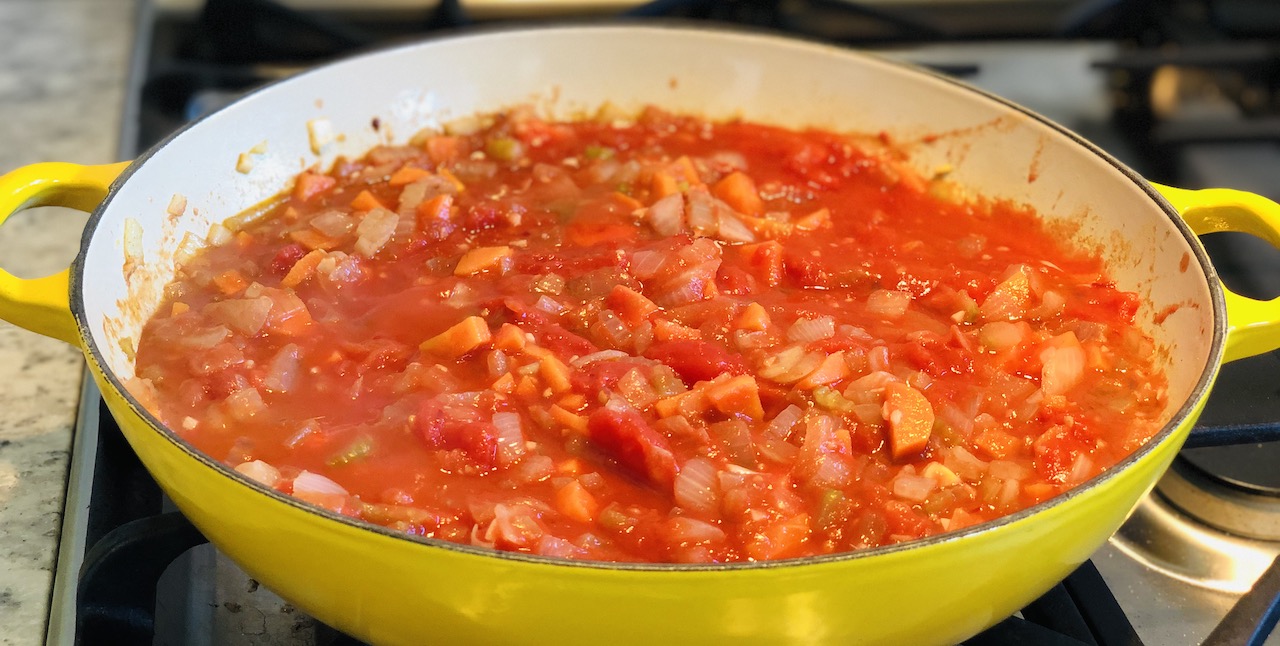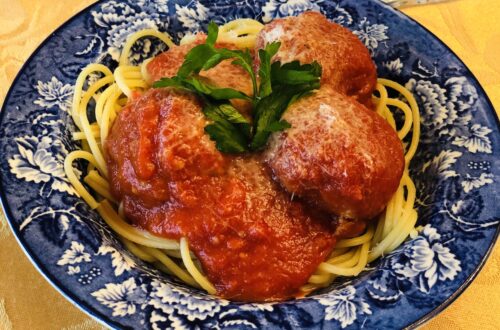
Mediterranean Fish Stew
At some point during my childhood, fish stew became the dish that my father and I cooked together. This was always an extensive process: we’d buy or make fish stock, which was either bland or way too fishy; we’d cook bacon, chop up all the vegetables, add everything to the pot; and then we’d step back and wait. We’d taste it, realize it was all wrong (often too fishy), and separate the whole thing out into two pots and more or less start over. Somehow it always ended up tasting good in the end, although I still don’t understand how.
More recently, we’ve cooked various Mediterranean-style fish stews. This recipe is the most recent and, in my view, by far the best. I’ve simplified the original recipe so it can be made with household spices, added raisins to contrast with the saltiness from the anchovies, and chosen to use chicken stock instead of water, which some may see as sacrilegious. I don’t care; it’s my kind of fish stew. (I’ve also added shrimp, because what’s a fish stew without shrimp.)
Cod is the center of this stew. A bottom-dwelling fish, cod was once everywhere in the Atlantic; it’s said that you used to be able to walk across the ocean on the backs of cod. But after centuries of fishing, by the 1990s the stock on the North American side of the Atlantic had been drastically reduced – off Canada down to 1 percent of its former level, while on the US side down to around 3 or 4 percent.
How did we destroy these seemingly endless cod stocks? Technological advancements had a lot to do with it (as did ignoring scientific data that the fish stocks were endangered). Better fishing boats and fishing technology led to fish being caught more quickly than they could reproduce. The advent of steam and then diesel engines and improved electronics (radar, sonar, and GPS) meant fishermen could steam farther out and more accurately target areas with fish. And as trawlers (or “draggers” as they’re called, since they drag their nets on the bottom of the ocean) became the norm, they became more efficient. Using large nets held on the ocean floor with chains (and later replaced with “rockhoppers” that moved over rocks without getting caught), a trawler could catch all the fish in its wake.
Finally, in 1992, in an attempt to save the cod stock, Canada shut down all cod fishing. But it was too late, and the stock has been slow to recover, especially on Georges Bank (which is shared by the US and Canada). Around the same time the US also limited cod fishing. While necessary to give cod stocks the chance to survive, these limits devastated fishing communities. The Canadian moratorium on cod fishing meant that 30,000 people lost their jobs over night. Since then, the communities have struggled with high levels of unemployment. Fishermen in New England have tried to hold on, but it’s grown increasingly difficult. In 2012 the federal government declared the Northeast groundfish fishery an economic disaster, leading to reduced catch limits and closures.
Today, there are still low limits on catches of cod off of North America. Because of these limits, in 2018 US fisherman caught only 2.2 million pounds of cod, compared with 100 million pounds per year in the 1980s. While overall it appears that cod populations are increasing, individual stocks vary – and there are over 24 stocks. Although the Atlantic stocks off of Canada and the US are still at risk, certain stocks on the European side of the Atlantic are faring better. Today, most cod sold in the US seems to come from Iceland, Norway, and Russia; and we import a whole lot of it, with over half a billion dollars of cod entering the US in 2017. Although Atlantic cod is thought to taste better, US-caught Pacific cod appears to be a good alternative, with the Bering Sea stock “above target population level.” However, the cod fishery in the Gulf of Alaska was closed for the 2020 fishing season amid concerns about the stock’s health, this time due to warmer waters caused by climate change. (NOAA has labeled the Gulf of Alaska cod stocks as “below target level,” but said that its “fishing rate promotes population growth.”)
How do you know what cod (or other fish) is sustainable, meaning that the stocks are large enough to be fishing? (There are other labor and environmental issues related to fishing that I’ll discuss some other time.) Well, it’s really difficult. Recently, a few groups have created websites that rate fish supplies. However, they are all pretty complicated and sometimes contradict each other. If you’re interested, check out Seafood Watch from the Monterey Bay Aquarium, as well as the Environmental Defense Funds’ Seafood Selector.
For an in-depth look at the history of cod, read Mark Kurlansky’s book, Cod: A Biography of the Fish That Changed the World (much of the information in this post comes from his book). It provides a wealth of information, including the history of battles over cod between Iceland and England and how New England cod fishing was involved in the slave trade. And to learn more about the impact on fishermen when the cod stocks collapsed (as well as about the fish mogul known as “the Codfather”), watch the Rotten episode on cod (Season 1, Episode 6) on Netflix.
Mediterranean Fish Stew
Course: Dinner, Recipe, Soup6
servings1
hour20
minutesAdapted from Easy Fish Stew With Mediterranean Flavors by Martha Rose Shulman.
Ingredients
4 anchovy fillets, soaked in water for 4-5 minutes, drained and rinsed
¾ teaspoon salt, plus more for sprinkling on the fish
2 tablespoons extra virgin olive oil
1 large onion, chopped
1 celery stick, chopped
1 medium carrot, chopped
4 garlic cloves, minced
¼ teaspoon red pepper flakes
½ teaspoon dried thyme
1 bay leaf
1 (28-ounce) can of whole tomatoes
2 cups chicken broth
2 cups water
1 pound of small red potatoes, washed and cut into half-inch pieces
¼ cup golden raisins
1-1½ pounds firm white fish, such as cod or halibut, cut into 3-inch pieces
½ pound of shrimp
Parsley for garnishing
Directions
- Soak the anchovies in water for 4-5 minutes. Take them out and drain them. Then mash together the anchovies and ¼ teaspoon salt. (If you have a mortar and pestle, you can use that; I mashed them against a glass with the back of a spoon, which worked fine.)

- In a large pot or Dutch oven, heat the olive oil over medium heat. Add the onion, celery, carrot, garlic, red pepper flakes, thyme, bay leaf, and ½ teaspoon salt. Cook for about five minutes, stirring occasionally, until the onion, carrots, and celery are tender.

- Add the anchovy and salt mixture. Continue cooking for about one minute, until fragrant.
- Add the tomatoes and cook for 5-10 minutes, allowing the mixture to cook down a little bit.

- Add the chicken stock, water, and potatoes and bring to a simmer. Once the soup has simmered for about 15 minutes, add the raisins. Simmer for another 10-15 minutes.
- Sprinkle salt and pepper on both sides of the fish and add the fish to the soup. If using shrimp, add that as well. Cook for another 5-10 minutes, until the fish and shrimp are cooked through. The fish will be flaky when it is done and the shrimp will be pink.

- Remove the soup from the heat, sprinkle parsley on top, and serve.

Notes





